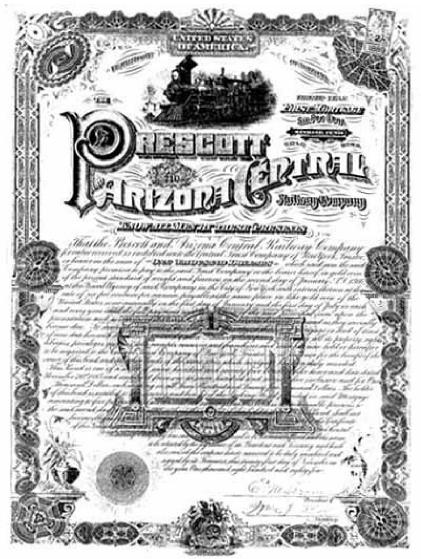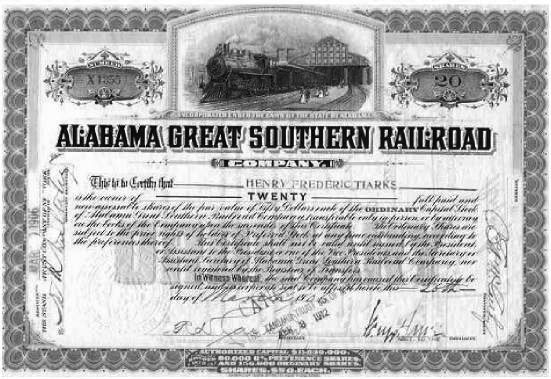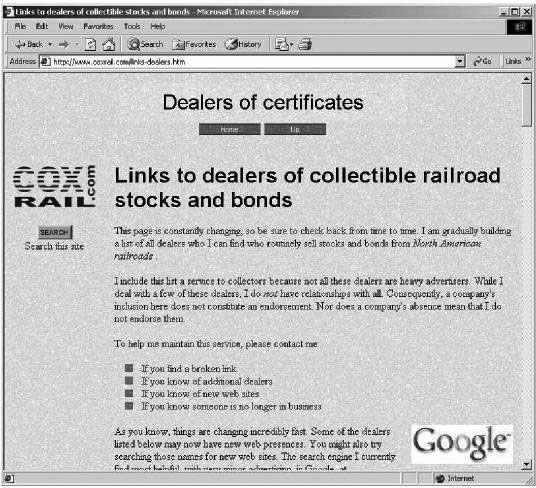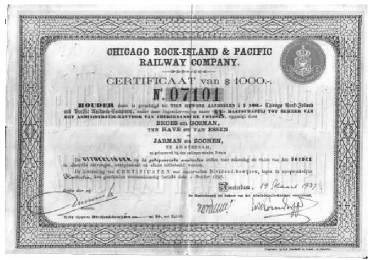
The Case for Serial Numbers
As best I can tell, the late Erik Boone seems to have been the first major dealer to routinely list serial numbers in his certificate descriptions. He seems to have started listing serial numbers in his catalogs about 1986, maybe sooner.
A few European dealers continue the tradition, but certainly not all. So far, only a tiny handful of American dealers have followed his lead.
May I humbly suggest the importance of including serial numbers in catalogs and articles?
By including serial numbers, advanced collectors and knowledgeable dealers can begin to determine just how scarce our certificates really are. Right now, rarity estimates are often little more than educated guesses.
Take, for instance, bonds from the Prescott & Arizona Central Railway Co. I know of two varieties: one from 1885 and one from 1886. Prices suggest the 1886 certificate (with a train waiting at a station) is thought to be the more common. Both certificates were issued in the Arizona Territory, so both are highly sought-after collectibles.
For cataloging purposes, I really would like to know the population of both bonds.
 1885 first mortgage gold bond from the Prescott & Arizona Central Railway Co. (PRE-125-B-50) Courtesy Jürgen von der Brake.
1885 first mortgage gold bond from the Prescott & Arizona Central Railway Co. (PRE-125-B-50) Courtesy Jürgen von der Brake.
At the time of the first edition, I only knew of two examples of the 1885 bond (with a man standing beside loco and tender.) A couple of years ago, I got serious about recording serial numbers in my database. Since then, I have recorded
Recording serial numbers is not easy. Normally, I rely on my near-sightedness to read or guess serial numbers from catalog photos. And I get a lot of serial numbers from the copies that collectors send.
One of the best sources for photos of railroad certificates is the internet. Thankfully, a few contributors send electronic copies they find on auction sites. Without their help, I would miss hundreds and hundreds of rarities. Unfortunately, the quality of internet photos is extremely poor. It is nearly impossible to discover serial numbers from web sources.
What set me off on this subject were suggestions from readers that I offer rarity estimates in my catalog instead of prices. And then show price ranges based on rarity.
Believe me, that approach would make things a lot easier. But I just cannot ignore two serious problems.
First, certificate prices are not directly related to rarity. Prices reflect demand. Demand only has an indirect relationship with rarity. There are thousands of examples of items whose prices are upside down from their rarities.
Take the quintessential stock certificate from the Harrisburg Portsmouth Mount Joy & Lancaster Rail Road Co. (HAR-465-S-50.) That certificate is extremely popular. It is in high demand. It always attracts prices in the $250 to $350 range. Still, I do not categorize the certificate as particularly scarce.
The second problem is the harder problem to solve. Currently, we cannot accurately quantify rarity on very many items. We simply have no dependable mechanism for tracking specific certificates. If everyone listed serial numbers in their descriptions, we might start to get a handle on rarity in a decade or so. Right now, we cannot.
I am not suggesting dealers list every single serial number of every single item. There is too little profit in common items to pay for the increased space requirements.
Still, it would help if we all started including serial numbers in our descriptions of world-class rarities.
What do I mean by “world-class?” Well, in the coin hobby, coins worth $500 are somewhat scarce, but certainly not rare. In our hobby, $500 certificates are extremely rare, possibly even unique. In fact, most $200 certificates are world-class collectibles in terms of rarity.
I never met Erik Boone in person, but I am told that he really respected the hobby. By the same token, I will probably never meet most of my contributors in person. Nonetheless, I can assure you that they too genuinely respect the hobby. They also want to help future generations of collectors. One of the easiest ways to do that is by leaving good records of the certificates we are seeing today.
3,994 New Varieties for the Second Edition (see page 2)
|
1st Edition |
2nd Edition |
Currently |
| Number of certificates listed (counting all variants of issued, specimens, etc.) |
8,559 |
14,112 |
14,163 |
| Number of distinct certificates known |
7,152 |
11,146 |
11,182 |
| Number of certificates with celebrity autographs |
699 |
1,175 |
1,179 |
| Number of celebrity autographs known |
232 |
342 |
342 |
| Number of railroads and railroad-related companies known |
17,276 |
19,905 |
19,811 |
| Number of companies for which at least one certificate is known |
3,516 |
5,001 |
5,015 |
Second Edition at BNR Press
As promised, I completed the second edition and shipped it off in electronic form to my publisher. It is substantially larger than the first edition.
I added a considerable amount of new text to the book. My goal was to answer the most common concerns and questions about stocks and bonds. I suspect, though, that new collectors are less concerned about the purposes of certificates than the listings.
To that end, the second edition contains 5,553 new listings. Meaning it will contain 56% more entries than the first edition! A little over three-quarters of those entries are completely new varieties.
 Ad from Leslie’s Illustrated Newspaper, Jan 20, 1872.
Ad from Leslie’s Illustrated Newspaper, Jan 20, 1872.
So, What’s Next?
After I completed the 1995 edition, I took about a year off. That was a big mistake. I got so far behind, that it took three to four years to catch up.
This time, I am continuing to research and add certificates for the 3rd edition without a break. Submittals are down considerably, but contributors have already managed to add 51 new certificates and 36 new varieties. And that is just in the last two weeks.
So, please, keep sending new material and new catalogs. As always, I cannot possibly afford to subscribe to all the auction catalogs out there. The harder we work right now, the more new items we will add to the third edition.
When and Where Will the Second Edition be Available?
As I write this newsletter, I cannot exactly answer those questions. Everything is in the hands of my publisher, BNR Press. (Remember, I am merely the author.) I suspect that many of the prominent certificate dealers will carry it as they did the first edition.
And to help them remain profitable, I strongly suggest that everyone buy from dealers, both here and in Europe.
I will, however, write you again, as soon as I learn the publish date, price, and additional details.
I will also post that information on the first page of my web site, COXRAIL.COM.

“Ordinary” shares from the Alabama Great Southern Railroad Co. (ALA-217-S-40) Courtesy Ken Holter.
Sending Electronic Images
As scanner prices drop, more and more people send images by e-mail. Making good images is tricky, so check out some tips and tricks on my “how to” page at coxrail.com/ howtoscan.htm. When scanning for e-mail purposes (as opposed to publication), remember these three main considerations: size, size, and size. In general,
Scan in color at about 150 dpi.
Scan against a white background.
Scan big items in pieces and send the separate pieces.
Scan in pieces with the top facing one direction.
Save in JPG format.
Decrease file size to 150 kb, maximum.
When sending several pictures, zip to save space.
Check My Web Site for Dealers
As I discover dealers who sell railroad certificates, I add them to my web site. Please check my list of active dealers at www.coxrail.com/Buying-Selling/Buying/Links-to-dealers

Thomas Schabmayr’s Book
Back in March, 2000, I suggested scripophily collectors use both my catalog and the catalog of Thomas Schabmayr: Wertpapiere der US — Eisenbahngesellshaften. While he and I cover the same topic, we inevitably discover and list different certificates.
Unfortunately, correspondents complained that it was hard to acquire Schabmayr’s book from North America. Plus, shipping costs are absurd! So, with the help of Stefan Adam at Adam Historical Shares, I will personally offer the latest edition of his book for the benefit of my readers.
Small Collections
A new contributor told me a few days ago that he was amazed he was able to contribute something because his collection was small. I hear that all the time.
Why? Because this is the golden age of scripophily. It is amazingly easy for all of us to acquire rarities. And cheaply.
Yes, some certificates sell for several hundred dollars. And yes, prices have risen dramatically in the last two to three years.
But, the number of people who collect certificates is still limited. Consequently, prices are absurdly low compared to their rarities. To gain perspective, check the current prices of coins and stamps against their levels in 1900. Or even 1950.
That is where certificate prices are today.
I am not saying that certificate prices are going to approach those of 1804 silver dollars anytime soon. But — and please understand this clearly — we have many certificates that are rarer than 1804 silver dollars!
And, believe it or not, some of you with small collections own those rarities. Never mind what you paid for them.
A few months ago, I picked up an issued Colorado railroad certificate for $25 at a local antique mall. It was the first such example I had ever encountered.
Now I am not saying that certificate is extremely valuable. Nor am I saying that it is one-of-a-kind. I am merely saying that I am a terribly small collector, smaller than almost every one of you. And yet, even at my level, I own a rarity or two. (I consider myself a cataloger, not a collector.)
So, just because you consider yourself a “small collector,” does not mean you don’t have anything to contribute.
And, as I have said for almost ten years, the hardest certificates for me to catalog are the so-called “common” certificates. They are the ones that dealers and catalogers never illustrate. If you think my descriptions of items need improving, it means I probably have not seen the certificates in person. Please, please, please send me copies.
And then, you can tell me how you are amazed that you were able to help the hobby.
(Oh, yes. You can still help by sending copies of equipment trusts. Every one you can send! Just reduce to 81/2 x 11.)
 CHI-603-S-44, for the Chicago Rock Island & Pacific Railway Co. Courtesy Geert Leemeijer.
CHI-603-S-44, for the Chicago Rock Island & Pacific Railway Co. Courtesy Geert Leemeijer.
Dutch Certificates
Several of these kinds of certificates, issued in Amsterdam before WWII, appeared last year from unknown sources. All the ones I have seen have a distinctly European appearance. They were all issued for large American companies such as the Wabash and the CRI&P. Does anyone know their origin and history?